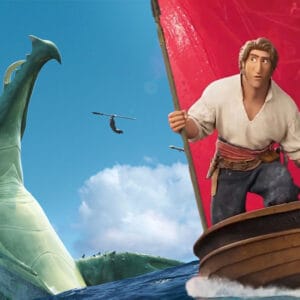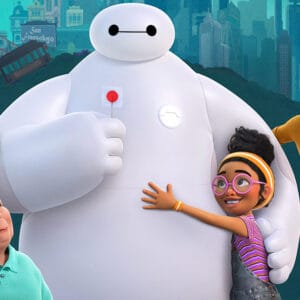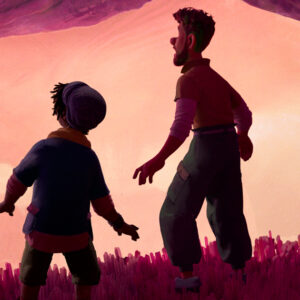Last Updated on August 2, 2021
Ink & Pixel is a source of pride and joy for me as a writer and as such, I'm always striving to take this column further for those who read and enjoy it. In an effort to widen the reach of our continuously growing fan-base, Ink & Pixel has broadened its horizons with the inclusion of films from the Horror, Sci-Fi, Action-Adventure, and Fantasy genres. Additionally, if you yourself, or anyone you know, helped to make any of the amazing feature films found within this column, I would love to talk to you to further my knowledge. Please contact me at [email protected] so we can discuss it further.

Ever since the Walt Disney Company acquired Marvel Comics back in 2009, many of the legendary comic book publishing group's characters have enjoyed a tremendous amount of success on the big screen. After a while, Marvel fans (myself included) wondered about when the House of Mouse would be making plans to expand their cinematic universe to include a full-length animated comic book-related feature. For years, message boards and list-oriented articles speculated wildly as to whether Disney would adapt yet another of their more popular properties, or perhaps take a chance at presenting viewers with something a bit more kid-friendly and lesser-known. Then, in June of 2012, Marvel and Disney announced plans to develop an obscure comic by the name of Big Hero 6 as their first major animated film featuring characters from the ever-expanding Marvel Universe.

The super hero team, Big Hero 6, made their leap onto the comic book page in September of the year 1998 as part of Sunfire & Big Hero 6 #1. Originally created by Steven T. Seagle and Duncan Rouleau, the group was meant to make their debut appearance as a guest-appearance in the book Alpha Flight #17. When scheduling conflicts brought that collaboration to a stand-still, writer/artist creative team Scott Lobdell and Gus Vasquez joined forces to offer up a three-issue mini-series featuring the members of a foreign and exciting new team called Big Hero 6!

Disney and Marvel's BIG HERO 6 is a 3D animated superhero comedy directed by both Don Hall and Chris Williams. With a screenplay written by Jordan Roberts, Dan Gerson, and Robert L. Baird, this science fiction fantasy adventure tells the story of Hiro, a 14-year-old robotics prodigy living with his Aunt Cass and genius brother, Tadashi, in the fictional city known throughout the Marvel Universe as San Fransokyo – an amalgam of San Francisco, California and Tokyo, Japan. After a tragic lab “accident” costs Tadashi his life, Hiro discovers that his brother's final project – an advanced caregiver robot by the name of Baymax – now belongs to him.

At first, Hiro rejects Baymax's attempts to comfort him, seeing the robot's advances as intrusive and nothing but a grim reminder of his brother's passing. Then, when Hiro begins to suspect that Tadashi's death might not have been an accident after all, he accepts Baymax's aid and looks to his dearly-departed sibling's co-workers: Go Go (Jamie Chung), Honey Lemon (Genesis Rodriguez), Wasabi (Damon Wayans Jr.), and Fred (T.J. Miller) for help in solving the mystery. Together, Hiro and Baymax set to work on designing super hero suit tech that's tailored to each of his teammates' areas of scientific expertise. With everyone properly geared, Hiro leads his new friends in an investigation into the suspicious activity of Robert Callahan – a shifty professor of robotics, and quite possibly, Tadashi's killer.

In the comic, it was originally Hiro's father who'd created Baymax. However, when sorting through the bits and pieces of the source material, Disney and Marvel arrived at the conclusion that it would serve the story best if it was Hiro's brother, Tadashi, who constructed the robot. Personally, I'm relieved that the creative teams chose to make this a “brothers” picture rather than another “father/son” narrative. There's no denying that Disney holds a tremendously successful track record regarding their use of the absent parent motif in their animated films, but a change in perspective can do wonders when used creatively, don't you think?

Interestingly enough, Don Hall grew up without ever experiencing what it's like to have a blood-related brother by his side. So, in an effort to better understand the bond that comes with that type of familial love, Hall invited his co-workers to join him in something of a “Brother Summit”, in which his guests shared stories about what it was like to grow up with another male sibling living among them. In fact, the film's Head of Story, Joe Mateo, identified with the film's lead character a great deal. As part of an interview Joe participated in for the Special Features section of the Blu-Ray release, he shares that at the tender age of just 5-years-old, he and his brother lost their mother. As a result, Joe felt a responsibility to help raise his younger sibling and keep a sharp eye on him as best he could. Without a doubt, this life experience allowed Joe to give the scenes shared by Hiro and Tadashi a level of authenticity and care that stemmed from a very personal place.

When designing the lovable, squishy, caretaker robot, Baymax, Don Hall explained to his team that he wanted the technology that made up the character to be as close to real as they could manage. Of course, when you're working for Disney, this means that a field trip is in order! To better understand the robotics industry's latest and greatest advancements, Hall arranged for he and his art design team to visit the Carnegie Mellon University’s Robotics Institute. While there, the group discovered a recent cybernetic breakthrough by way of Soft Robotics. Essentially, what they'd found was an arm that had a substructure, but was then covered with an inflatable vinyl – meant to be used in the healthcare industry upon completion. Seriously, how perfect and fortuitous is that? Not only did the intended nature of the tech match that of Baymax's directive, but the puffy, balloon-like material would also serve to give him an inviting and huggable visual exterior.

With the mechanical particulars and body design of the character complete, it was then time to discover what Baymax's face might look like. Then, while visiting a shrine in Tokyo, Japan, the film's Lead Character Designer, Shiyoon Kim, discovered a series of bells sporting a look that was perfect for their good-natured automaton. Brown in color, these rounded bells contained a slit at their base that reached to two small, heart-shaped holes on either side. When looking at the bell from a particular angle, one could certainly identify what appears to be a friendly and smiling face staring back. Rather than keep the heart-shaped holes, though, Baymax's eyes were then simplified, if you will, by having them look like expressionless circles instead. Also, I use the term “expressionless” not to make the design sound unappealing or lifeless, but because the artist's intention was for Baymax to emote with his entire body and not just through the use of a warm expression on his face.

Now, everyone knows that Disney is in the business of pushing itself to the limit whenever they are presenting their next major animated film project – and I'd like to tell you why BIG HERO 6 was no exception to this tradition. In an effort to take their effects to the next level, Disney developed a new technology called a Hyperion Renderer. This fancy sounding art program was used to create a very realistic light simulation script throughout the film. Basically, you could take any photo you please, feed it into the Hyperion Renderer program, and the results would be that of a picture-perfect facsimile. Normally, artists would have to create a scene, and then drag and drop digital lightning rigs into the art for it to achieve the desired level of luminosity. With the Hyperion Renderer, nuances to the art's lightning would be recognized and applied automatically, saving the artist precious time and (more or less) eliminating the need for guess-work. The program took a total of 3 years to develop and is now being used across all of Disney's film-related endeavors.

After a whopping 203 days worth of silver screen time, BIG HERO 6 managed a world-side box office total of $657,818, 612! Wow! That is a mighty impressive number, especially when you consider that the movie was made using only a budget of $165 million! Which begs the question as to why Disney/Marvel has yet to officially announce either a sequel or perhaps another project intended for an animated release. As if these numbers weren't convincing enough, BIG HERO 6 was also a splash during awards season when it grabbed up the gold-covered naked man statue for Best Animated Feature at the 87th Academy Awards. Additionally, The film received several more awards during its applicable season with the following: Best Animated Feature and Animated Effects at the 42nd Annual Annie Awards, the Favorite Animated Movie during the Kid's Choice Awards, Best Family Film courtesy of the Women Film Critics Society, and last but certainly not least, a total of 5 awards at the 13th Annual Visual Effects Society Awards for outstanding excellence in several tech-related categories.

For me, BIG HERO 6 marks what is hopefully the beginning of a long-standing history-to-come of Disney/Marvel building a long list of comic to animated film adaptations. There are so many characters and franchises to choose from their all-ages line of comics that would be perfect for the big screen. Power Pack, anyone? Or how about Kamala Khan as Ms. Marvel starring in her own animated feature? I think that would be incredible! In regard to BIG HERO 6, I think it's a wonderful film. In all honesty, the semi-final moments in which Hiro and Baymax are forced to part ways very nearly broke me as much as the ending of TOY STORY 3. Not only do I applaud the film for presenting viewers with a diverse cast of characters, but for also pushing the ideas of science and ingenuity as a super power in and of itself. With such a big reception to the film, one has to wonder what else Disney and Marvel have planned for their animated universe. I guess we'll just have to wait and see. Be well, and “Balalalalala!”




















Follow the JOBLO MOVIE NETWORK
Follow us on YOUTUBE
Follow ARROW IN THE HEAD
Follow AITH on YOUTUBE